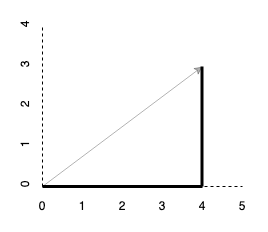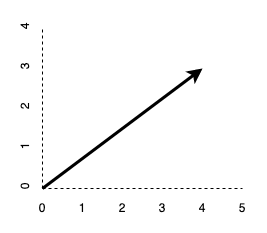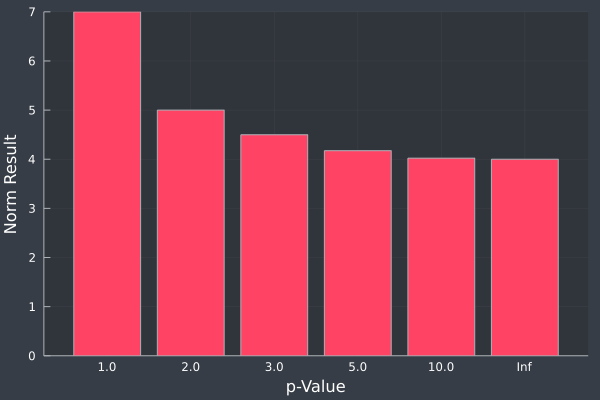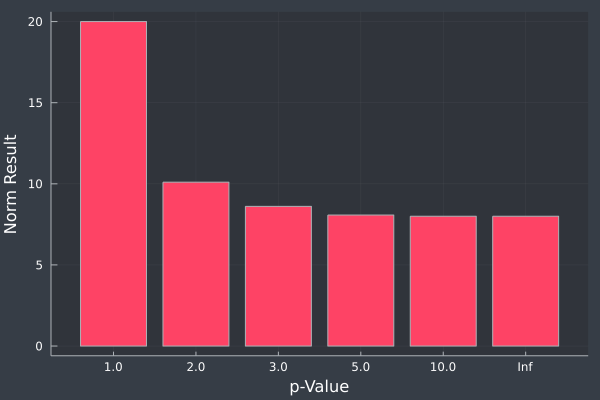Norms
Norms are a generalization of a length function and ultimately are used for computing the length of vectors in an abstract vector space.
Let \(V\) be an abstract vector space over a field \(\mathbb{F}\). The norm is a function, \(\eta : V \rightarrow \mathbb{R}\) such that,
\(\eta(x + y) \leq \eta(x) + \eta(y)\) for all \(x, y\) in \(V\).
\(\eta(\alpha x) = \vert \alpha \vert \eta(x)\) for all \(x\) in \(V\) and \(\alpha\) in \(\mathbb{F}\).
For all \(x\) in \(V\), \(\eta(x) = 0\) if and only if \(x = 0\).
For each of the following norms I discuss below, I've provided an implementation in Julia. That being said, there's a great package
Distanceswhich includes all of these and more. While my implementations are good for solidifying the concepts behind the individual functions, they are likely not as efficient as those defined inDistances.
Absolute Value Norm
The absolute value function,
\[ \eta(x) = \vert x \vert\,. \]In \(1\)-dimensional space, the vector which extends from the origin to \(\pm x\) has a length of \(x\).

The vector \(\pm 4\) has a length of \(4\).
\(\ell^1\) Norm
The \(\ell^1\) norm will trace along the individual components of a vector rather than calculate the distance along the hypotenuse,
\[ \eta(x) = \sum_{i=1}^n \vert x_i \vert \,.\]
Therefore, by the \(\ell^1\) norm, the \((4, 3)\) vector has a length of \(4 + 3 = 7\).
l1_norm(X) = [abs(x) for x in X] |> sum
l1_norm([4 ; 3])
> 7\(\ell^2\) Norm
The \(\ell^2\) norm is for computing the length of a vector in \(n\)-dimensional space, defined as,
\[ \eta(x) = \lVert \mathbf{x} \rVert = \sqrt{x_1^2 + \cdots + x_n^2 }\,. \]Notice that this is the same as the square root of the inner product of a vector with itself, \(\sqrt{\mathbf{x}\boldsymbol{\cdot} \mathbf{x}}\).

By the \(\ell^2\) norm, the vector \((4, 3)\) has a length of \(\sqrt{3^2 + 4^2} = \sqrt{9 + 16} = \sqrt{25} = 5\).
l2_norm(X) = [x*x for x in X] |> sum |> sqrt
l2_norm([4 ; 3])
> 5.0\(\ell^p\) Norm
The \(\ell^p\) norm is not actually a single norm, but a generalization of multiple norms.
\[\eta(x) = \lVert \mathbf{x} \rVert_p = \Big( \sum_{i=1}^n \vert x_i \vert^p \Big)^{1/p}\,.\]It's trivial to see that when \(p = 1\), we get the \(\ell^1\) norm, when \(p = 2\), we get the \(\ell^2\) norm, and so on. When \(p\) approaches \(\infty\), then we get the infinity norm which is defined as,
\[\eta(x) = \lVert \mathbf{x} \rVert_\infty = \max_i \vert x_i \vert \,.\]l∞_norm(X) = [abs(x) for x in X] |> maximum
l∞_norm([4 ; 3])
> 4Therefore, we can write a generalized function to handle any \(\ell^p\) norm as follows.
function lp_norm(X; p = 1)
if isinf(p)
[abs(x) for x in X] |> maximum
else
([abs(x)^p for x in X] |> sum)^(1/p)
end
end
@testset "ℓp Norms" begin
X = [ 4 ; 3 ]
@test lp_norm(X) == 7.0
@test lp_norm(X; p=2) == 5.0
@test lp_norm(X; p=Inf) == 4.0
end
> Test Summary: | Pass Total
> ℓp Norms | 3 3Interestingly, as \(p\) approaches \(\infty\), the result of \(\eta_p(x)\) approaches a minimum. The minimum here is, in fact, the maximum, unsigned component of \(\mathbf{x}\).
Looking at the \(p\) values of \(1\), \(2\), \(3\), \(5\), \(10\), and \(\infty\), for the \(2\)-dimensional vector, \((4, 3)\).

Plotting the same \(p\) values for a \(5\)-dimensional vector, \((4, 3, -2, 3, 8)\).
